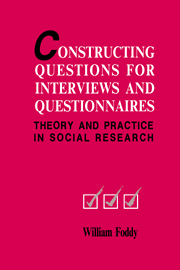Book contents
- Frontmatter
- Contents
- Tables
- Figures
- Preface
- Chapter 1 An initial statement of the problem
- Chapter 2 A theoretical framework
- Chapter 3 Defining topics properly
- Chapter 4 Formulating intelligible requests for information
- Chapter 5 Contextual influences on respondents' interpretations of questions
- Chapter 6 The need to provide response frameworks
- Chapter 7 The limitations of human memory
- Chapter 8 Filters: establishing the relevance of questions to respondents
- Chapter 9 Reducing question threat
- Chapter 10 The open vs. closed questions debate
- Chapter 11 Measuring attitudes
- Chapter 12 Checks to ensure that questions work as intended
- Chapter 13 Concluding comments
- The tap paradigm
- References
- Index
- Acknowledgements
Chapter 6 - The need to provide response frameworks
Published online by Cambridge University Press: 04 September 2009
- Frontmatter
- Contents
- Tables
- Figures
- Preface
- Chapter 1 An initial statement of the problem
- Chapter 2 A theoretical framework
- Chapter 3 Defining topics properly
- Chapter 4 Formulating intelligible requests for information
- Chapter 5 Contextual influences on respondents' interpretations of questions
- Chapter 6 The need to provide response frameworks
- Chapter 7 The limitations of human memory
- Chapter 8 Filters: establishing the relevance of questions to respondents
- Chapter 9 Reducing question threat
- Chapter 10 The open vs. closed questions debate
- Chapter 11 Measuring attitudes
- Chapter 12 Checks to ensure that questions work as intended
- Chapter 13 Concluding comments
- The tap paradigm
- References
- Index
- Acknowledgements
Summary
We turn now to explore both the nature and çonsequences of a number of decisions which respondents must make when they formulate answers to questions that have been put to them (see figure 6.1, p. 77).
The decisions the respondents make define the kinds of answers they give. The basic thesis is that answers are always formulated within response frameworks; this chapter deals with the problem of defining these response frameworks.
That different respondents often give quite different kinds of answers to the same question is a commonplace observation. Similarly, it is commonly observed that respondents often seem to have very different things in mind when they give objectively identical answers to the same question. Methodologists have used the concept of ‘perspective’ or ‘frame of reference’ to explain these observations (see, e.g., Lazarsfeld, 1944; Crutchfield and Gordon, 1947; Kahn and Cannell, 1957). Although the ‘perspective’ concept has never been properly defined, the basic insight is that it is possible for respondents to respond to a topic in a large (perhaps infinite) number of different ways when answering a question about it.
It should be said at the outset, however, that the ‘perspective’ concept is not a simple one. Differences in past experiences can cause respondents to respond to the same topic in different ways (e.g. in terms of how it relates to their economic, political, religious or domestic situations).
- Type
- Chapter
- Information
- Constructing Questions for Interviews and QuestionnairesTheory and Practice in Social Research, pp. 76 - 89Publisher: Cambridge University PressPrint publication year: 1993



